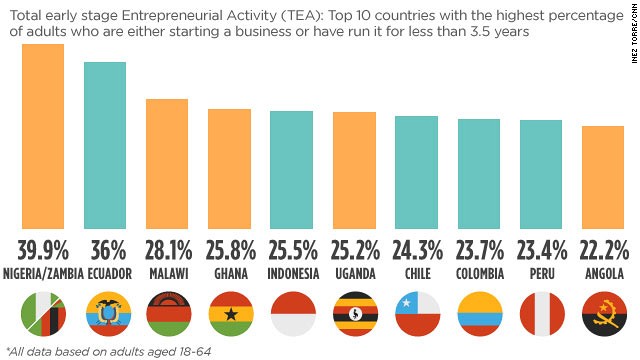Increasing access
to finance, financial literacy and building networks of African women have been
highlighted as ways to help more women become entrepreneurs.
In Nigeria,
Africa’s largest economy and most populated country, women are more financially
excluded. According to a 2012 survey by Enhancing Financial Inclusion and
Access (EFInA), 43.5 percent of Nigerian women are unbanked compared with 36.1
percent for men.
In addition
to limited access to credit, the low degree of women participating in the
formal sector and certain social norms, for instance women’s rights to
inheriting property, restrict the role of women in the economy.
Though
there are business opportunities equally available to both women and men, there
are specific problems that women face when starting or running a business or a
farm.
More women
participate in the informal sectors such as agriculture and, wholesale and
retail trade but their contribution is not captured. Nigerian women farmers
produce less per hectare than their male counterparts – in the north the
difference is 46 percent and 17 percent in the south.
The gap is
output is both due to lack of inputs and lower returns when they have the same
inputs as men. This is because they lack inputs e.g. labour, fertilizer,
information, access to markets and poor education, according to World Bank
report.
A little over
half of the jobs generated in the fourth quarter of 2012 and first quarter of
2013 were filled by women, mainly in health and social services sector,
according to the National Bureau of Statistics. Initiatives such as the YouWiN
for 3,000 women in 2013 are supposed to correct the imbalance. More can be
done.
Addressing
this problem calls for strategies that focus on equipping women at, for
example, the bottom of pyramid through cooperatives, microfinance etc. While
for those at the middle of pyramid skill sets like an MBA which will make them
attractive to investors are likely more applicable.
Programmes
for budding women entrepreneurs, for example, the five-year 10,000 Women
programme sponsored by Goldman Sachs, an investment bank, are essential for teaching
the fundamentals of business.
Women
entrepreneurs have to understand financial management and embrace technology.
They need to know how to run a structured business. They need to understand
that you don’t take cash from sales to pay school fees. They need to overcome
their phobia for technology because the businesses of today and tomorrow are
tied to technology.
Corporate
organisations keen on tapping into the significant economics and demography
that women present can initiate programmes that target women by opening
opportunities for them in their supply chain. There are several case studies of
how companies are benefiting commercially from including women in their value
chains. Big retail outlets can help women-owned micro enterprises to develop
the skills to grow their business such as packaging, branding and book keeping.
Because
procurements don’t require collateral such initiatives will in turn encourage
banks to finance women. However, women entrepreneurs must be cautioned. Banks
will make finance accessible if they have savings, no matter how much they
earn. They must know that equity is important. Banks need to see commitment.
Security is important for banks.
We totally
agree that “investing in women is smart economics”. We are convinced and
support the fact that there can be no inclusive growth if majority of Africa’s
demographic is left behind.
However for both present and future
businesswomen we cannot harp enough on the importance of getting involved,
applying for programmes and grants and
finding out what it takes to supply companies like MTN, Dangote etc.
From Business Day













